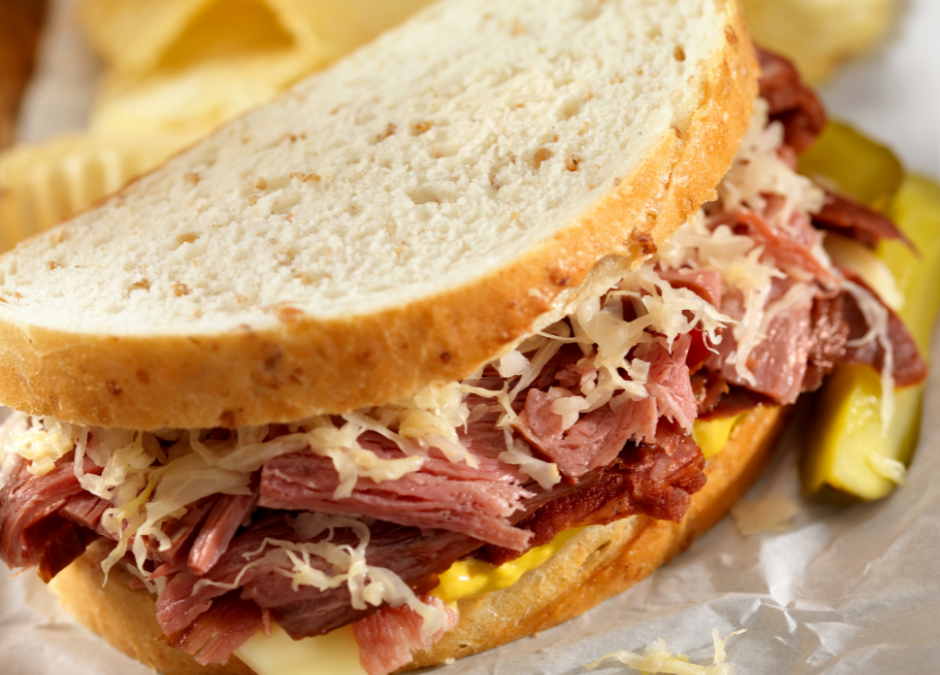How Did These Popular Jewish Deli Meats Originate? How Does Corned Beef Differ from Pastrami?
Corned beef on rye…pastrami piled high on an onion roll…two of the staples of any good Jewish deli. It may surprise you to learn that, while pastrami has its roots steeped in Jewish culture and tradition, corned beef came to the Jewish community from…you guessed it…the Irish.
What Is Corned Beef?
First and foremost, corned beef comes from the brisket of a cow. The brisket, part of the lower breast between the shoulder and the chuck, is prized for its blend of marbling, fat and connective tissues. Because it’s a slightly tougher cut of meat, it’s commonly cooked at lower temperatures for many hours, so that it becomes tender and juicy.
To make corned beef from a brisket, you marinate the cut of meat in a brine for anywhere from 5 to 20 days. The ingredients in the brine can vary to some degree, but commonly contain pickling spices, and pink curing salt. It’s the salt that gives corned beef its distinctive color. After brining the meat for the desired period of time, you typically rinse it and simmer it in a new brine for 5-7 hours, until tender.
What Are the Origins of Corned Beef?
Though corned beef has its origins in Ireland, beef was never a staple of the Irish diet until the British invaded and took over most of the island, bringing beef cattle with them. Because the British prohibited the import of Irish beef into England, the Irish had to find a way to keep the meat from spoiling. They did that by using large kernels of rock salt, called “corns.” Gradually, other spices were added in the corning process, leading to the distinct flavor of corned beef.
Corned beef first became associated with Jewish culture in the 19th century in America, as many Irish and Jewish immigrants settled side-by-side in some of the nation’s largest urban communities. Both faced significant prejudice and hardship, which created a common bond. To make their corned beef, the Irish immigrants turned to the kosher butchers nearby. The Irish shared their corned beef with the local Jewish communities and it became a staple, though Jewish corned beef tends to lean more toward garlic and onion than the Irish pickling spices.
What Is Pastrami?
Pastrami, while brined like corned beef, comes from a different cut of meat: it may be either the deckle, a lean shoulder cut, or the navel, a more succulent cut from just below the ribs. Although much pastrami found today uses the brisket, that it not true pastrami.
Like corned beef, pastrami is brined before it is cooked. The brine will often be exactly the same as the corned beef brine. However, once the meat is taken out of the brine, the spices used tend to be very different. Corned beef often gets little or no added spice, whereas pastrami may get a wide range of coatings, most often black pepper and mustard seed, but also fennel and even fresh garlic.
The other fundamental difference between corned beef and pastrami is the way it is cooked. While corned beef is essentially stewed in liquid, pastrami is most often smoked, typically with milder woods such as apple, cherry or maple.
What Are the Origins of Pastrami?
The word “pastrami” comes from the Turkish pastirma, which translates as “to press.” It came to the United States with the large emigration of Jewish people from Romania and Bessarabia in the latter part of the 19th century. In Romania, goose breasts were the preferred meat for pastrami, simply because they were plentiful. However, beef was cheaper than goose in the New World, so immigrants soon substituted beef navel. The first known pastrami sandwich in the United States was served by Sussman Volk, a kosher butcher in New York. Legend has it that Volk, a Lithuanian immigrant, got the pastrami recipe from a Romanian friend. The sandwiches were so popular that he stopped working as a butcher and opened a restaurant.
Gutterman’s and Gutterman Warheit—Meeting Your Funeral and Burial Needs for Five Generations
At Gutterman’s and Gutterman Warheit, with chapels in New York and Florida, we have provided comprehensive funeral and burial services to individuals and families in the Jewish community for more than 125 years. We can provide guidance and support on every detail after the death of your loved one, helping you select a monument, working with you to put together the order of service for the memorial, selecting a casket, making preparations for sitting Shiva or creating a Yahrzeit calendar. We will also work directly with the Chevra Kadisha to ensure proper ritual cleansing of the body before burial.
To learn how we can be of assistance, contact us by email or call us at one of the numbers listed below.
Gutterman’s & Gutterman Warheit — Where Relationships Matter
Family Owned and Operated Since 1892
Rockville Centre: (516)764-9400 | Woodbury: (516)921-5757 | Brooklyn: (718)284-1500
Boca Raton, FL: (561)997-9900 | (800)992-9262

